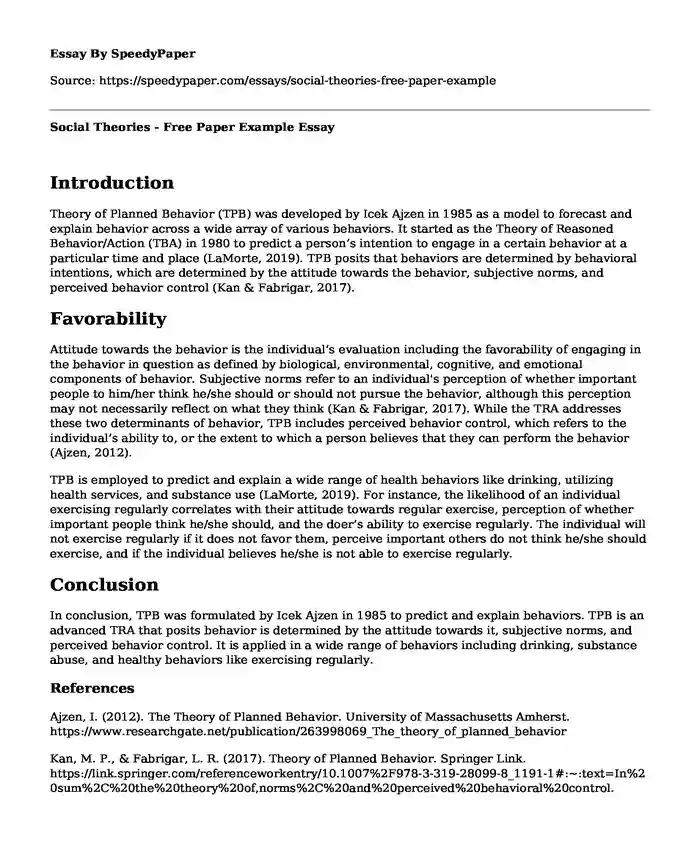
| Type of paper: | Essay |
| Categories: | Social change Behavior change |
| Pages: | 2 |
| Wordcount: | 381 words |
Introduction
Theory of Planned Behavior (TPB) was developed by Icek Ajzen in 1985 as a model to forecast and explain behavior across a wide array of various behaviors. It started as the Theory of Reasoned Behavior/Action (TBA) in 1980 to predict a person’s intention to engage in a certain behavior at a particular time and place (LaMorte, 2019). TPB posits that behaviors are determined by behavioral intentions, which are determined by the attitude towards the behavior, subjective norms, and perceived behavior control (Kan & Fabrigar, 2017).
Favorability
Attitude towards the behavior is the individual’s evaluation including the favorability of engaging in the behavior in question as defined by biological, environmental, cognitive, and emotional components of behavior. Subjective norms refer to an individual's perception of whether important people to him/her think he/she should or should not pursue the behavior, although this perception may not necessarily reflect on what they think (Kan & Fabrigar, 2017). While the TRA addresses these two determinants of behavior, TPB includes perceived behavior control, which refers to the individual’s ability to, or the extent to which a person believes that they can perform the behavior (Ajzen, 2012).
TPB is employed to predict and explain a wide range of health behaviors like drinking, utilizing health services, and substance use (LaMorte, 2019). For instance, the likelihood of an individual exercising regularly correlates with their attitude towards regular exercise, perception of whether important people think he/she should, and the doer’s ability to exercise regularly. The individual will not exercise regularly if it does not favor them, perceive important others do not think he/she should exercise, and if the individual believes he/she is not able to exercise regularly.
Conclusion
In conclusion, TPB was formulated by Icek Ajzen in 1985 to predict and explain behaviors. TPB is an advanced TRA that posits behavior is determined by the attitude towards it, subjective norms, and perceived behavior control. It is applied in a wide range of behaviors including drinking, substance abuse, and healthy behaviors like exercising regularly.
References
Ajzen, I. (2012). The Theory of Planned Behavior. University of Massachusetts Amherst. https://www.researchgate.net/publication/263998069_The_theory_of_planned_behavior
Kan, M. P., & Fabrigar, L. R. (2017). Theory of Planned Behavior. Springer Link. https://link.springer.com/referenceworkentry/10.1007%2F978-3-319-28099-8_1191-1#:~:text=In%20sum%2C%20the%20theory%20of,norms%2C%20and%20perceived%20behavioral%20control.
LaMorte, W. W. (2019). Behavioral Change Models: The Theory of Planned Behavior. Boston University School of Public Health.
https://sphweb.bumc.bu.edu/otlt/MPH-Modules/SB/BehavioralChangeTheories/BehavioralChangeTheories3.html.
Cite this page
Social Theories - Free Paper Example. (2023, Nov 25). Retrieved from https://speedypaper.com/essays/social-theories-free-paper-example
Request Removal
If you are the original author of this essay and no longer wish to have it published on the SpeedyPaper website, please click below to request its removal:
- Essay Sample: Effects of Sleep on Reaction Time in Driving
- Paper Example on an Ethnography of Social Interaction at the Bus Stop
- Paper Exampl on Business Solutions for the Disabled
- Essay Sample on Models for Organizational Change
- Essay Example: Background of Why the Study Was Done
- Free Essay Sample on Concepts of Health and Illness
- Free Essay: Connections of Chronic Diseases and Socio-Dynamic Cues
Popular categories




